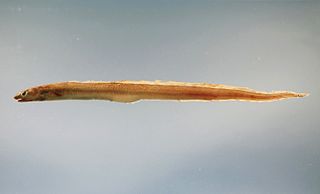
Conger is a genus of marine congrid eels. It includes some of the largest types of eels, ranging up to 2 m (6 ft) or more in length, in the case of the European conger. Large congers have often been observed by divers during the day in parts of the Mediterranean Sea, and both European and American congers are sometimes caught by fishermen along the European and North American Atlantic coasts.

The Congridae are the family of conger and garden eels. Congers are valuable and often large food fishes, while garden eels live in colonies, all protruding from the sea floor after the manner of plants in a garden. The family includes over 220 species in 32 genera.

The superorder Elopomorpha contains a variety of types of fishes that range from typical silvery-colored species, such as the tarpons and ladyfishes of the Elopiformes and the bonefishes of the Albuliformes, to the long and slender, smooth-bodied eels of the Anguilliformes. The one characteristic uniting this group of fishes is they all have leptocephalus larvae, which are unique to the Elopomorpha. No other fishes have this type of larvae.
Gnathophis is a genus of marine congrid eels.

Gymnothorax is a genus of fish in the family Muraenidae found in Atlantic, Indian, and Pacific Oceans. With more than 120 species, it the most speciose genus of moray eels.

Eels are ray-finned fish belonging to the order Anguilliformes, which consists of eight suborders, 20 families, 164 genera, and about 1000 species. Eels undergo considerable development from the early larval stage to the eventual adult stage and are usually predators.

Ariosoma is a genus of marine congrid eels.

Cynoponticus is a genus of marine ray-fiined fishes belonging to the family Muraenesocidae, the pike congers. The fishes in this genus are found in the Eastern and Western Atlantic Oceans and the Eastern Pacific Ocean, with a single parapatric species in each region.
Bathycongrus is a genus of eels in the family Congridae.

Bathyuroconger is a genus of eels in the family Congridae. It currently contains the following species:
Parabathymyrus is a genus of eels in the family Congridae.
Ariosoma meeki is an eel in the family Congridae. It was described by David Starr Jordan and John Otterbein Snyder in 1900, originally under the genus Congrellus. It is a subtropical, marine eel which is known from Japan and the Peng-hu Islands, in the northwestern Pacific Ocean. Males are known to reach a maximum total length of 53 centimetres.
Gnathophis grahami, or Graham's conger, is an eel in the family Congridae. It was described by Emma Stanislavovna Karmovskaya and John Richard Paxton in 2000. It is a subtropical, marine eel which is known from New South Wales, Australia, in the southwestern Pacific Ocean. It dwells at a depth range of 50–350 metres.
Rhynchoconger ectenurus, known commonly as the longnose conger in Australia, is an eel in the family Congridae. It was described by David Starr Jordan in Robert Earl Richardson in 1909, originally under the genus Leptocephalus. It is a marine, subtropical eel which is known from the western Pacific Ocean, including northern Australia, Japan, the Korean Peninsula, and the eastern China Sea. It inhabits soft sediments on the continental shelf and slope. Males can reach a maximum total length of 65 centimetres.
Rhynchoconger guppyi is an eel in the family Congridae. It was described by John Roxborough Norman in 1925, originally under the genus Congromuraena. It is a marine, tropical eel which is known from the western central Atlantic Ocean, including the Gulf of Mexico, the Caribbean, northern South America and southern Brazil. It dwells at a depth range of 137 to 458 metres, and inhabits the continental slope. Males can reach a maximum total length of 95 centimetres (37 in).
The bignose conger is an eel in the family Congridae. It was described by David Starr Jordan and Charles Harvey Bollman in 1890. It is a tropical, marine eel which is known from the eastern central and southeastern Pacific Ocean, including Chile, Colombia, Costa Rica, Ecuador, El Salvador, Guatemala, Honduras, Mexico, Nicaragua, Panama, and Peru. It dwells at a depth range of 25–90 metres. Males can reach a maximum total length of 40 centimetres, but more commonly reach a TL of 30 cm.

Rhynchoconger trewavasae is an eel in the family Congridae. It was described by Adam Ben-Tuvia in 1993. It is a marine, deep water-dwelling eel which is known from the western Indian Ocean, including the Gulf of Aqaba and possibly the Gulf of Suez. A single specimen was recorded in the Mediterranean Sea from Israel in 1993. It dwells at a depth range of 300 to 500 metres, and swims in a zigzag motion near the bottom. Males can reach a maximum total length of 57 centimetres (22 in), but more commonly reach a TL of 45 centimetres (18 in).
Gymnothorax tamilnaduensis is a species of moray eel native to the southeast coast of India, more specifically the Bay of Bengal, on the coast of Tamil Nadu. The body lacks any pattern of spots or stripes, and is very short compared to other morays. The first specimens of the species were collected at a depth of 25–30 meters.
Rhynchoconger bicoloratus is a species of deep-water conger eel native to the Indian Ocean. It was described through specimens captured in Kalamukku fishing harbor, off Kochi, Arabian Sea, from a depth beyond 200 m.
Rhynchoconger smithi is an eel in the family Congridae.









